The Rehoboth Beach Convention Center is mobbed with greyhounds, hundreds of them swaddled in bright fleece jackets to protect their chilly little bones from the wind. As I push through the doors, I’m ensnared in a traffic jam of dogs, a tangle of leashes and butt-sniffing, the sound of claws clattering on the epoxy floor. An older woman with a platinum-blond coif dances her fake nails along the neck of a stranger’s dog. “I’m a sucker for fawns,” she says, delighting in its dune-colored fur—and I, too, want to touch every last greyhound, put my face right into their long, spindly snoots and stare into their ridiculous chocolate eyes. As I wander the aisles of vendors (Technicolor leashes, bejeweled collars, paintings of greyhounds sprinting through psychedelic scenes), it’s like my brain has been dropped into a warm dopamine bath.
I’m at this event due to a fateful encounter. In 2018, I was walking my greyhound, Morticia, when a stranger stopped us on the street. He was a greyhound fanatic, an older guy in a rumpled tweed suit who wanted to pet my dog. As he rubbed her—a banged-up and skittish creature who had recently retired from racing—he made a series of odd confessions: that watching his greyhound die was harder than losing his parents, that he would have given his kidney if it could have prolonged his dog’s life. Clearly, this man was having an ecstatic experience of dog ownership—much different than mine, which had so far involved exterminating fleas and the expensive surgical removal of a menstrual cup that Morticia swallowed whole. I wanted whatever he was having, so when he mentioned Greyhounds Reach the Beach—an annual greyhound convention in Delaware, with five days of lectures, social events, frolicking, and canine fashions—I took note.
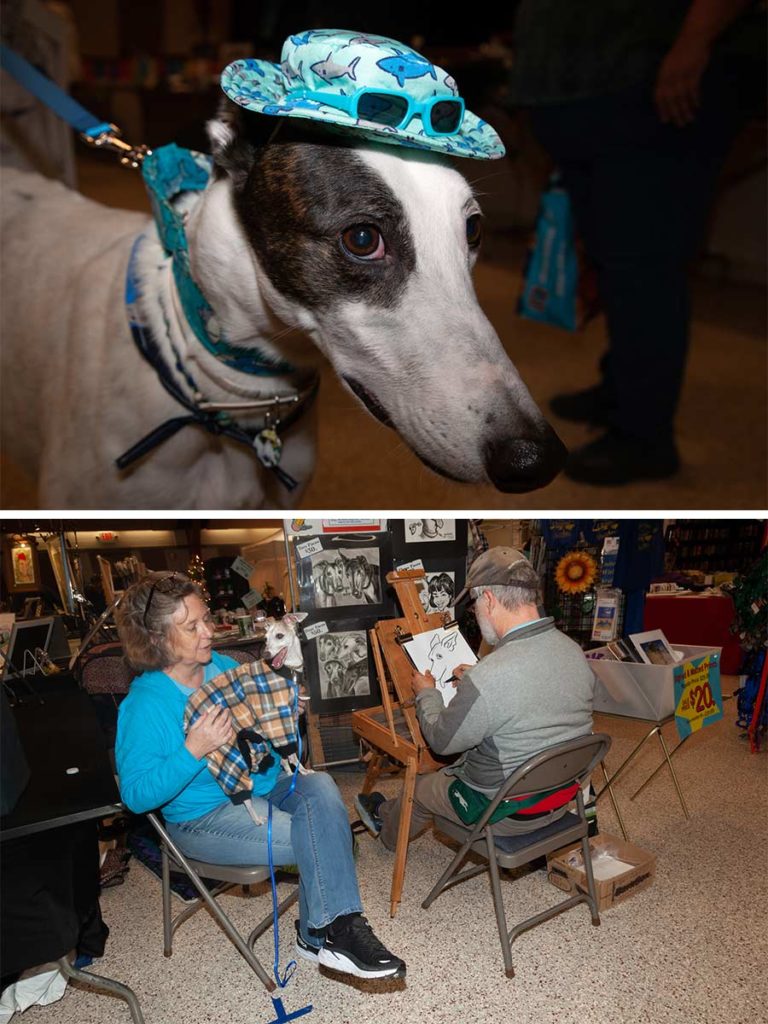 This year, Morticia and I have finally reached the beach, alongside roughly 400 human attendees, many escorting multiple dogs. In the convention center, a tiny woman is herding six of them through the scrum, her wrists trussed with leashes. There’s a greyhound caricature artist, a whippet dressed as a jack-o’-lantern, two Italian greyhounds chauffeured around in a pushcart, a spotted grey in a baby-blue beach hat with tiny sunglasses perched on the brim. I snap a picture of a sparkly sequined greyhound sweater, and a lady with a leathery face barks, “These are federally trademarked, and I am serious about my trademarks,” so I skitter outside and find two whippets lounging in the sunshine. The woman leashed to them says, “I could tell Liam was getting overwhelmed. It was a lot for him.”
This year, Morticia and I have finally reached the beach, alongside roughly 400 human attendees, many escorting multiple dogs. In the convention center, a tiny woman is herding six of them through the scrum, her wrists trussed with leashes. There’s a greyhound caricature artist, a whippet dressed as a jack-o’-lantern, two Italian greyhounds chauffeured around in a pushcart, a spotted grey in a baby-blue beach hat with tiny sunglasses perched on the brim. I snap a picture of a sparkly sequined greyhound sweater, and a lady with a leathery face barks, “These are federally trademarked, and I am serious about my trademarks,” so I skitter outside and find two whippets lounging in the sunshine. The woman leashed to them says, “I could tell Liam was getting overwhelmed. It was a lot for him.”
Around sunset, Morticia and I head to Dewey Beach for the “blessing of the hounds.” Beneath pink cotton-candy clouds, she trots onto the sand, the waves lapping at her crooked toes. There’s a full moon rising over an altar rimmed with fake flowers, adorned with candles and vases of brush. Beside the altar, speakers are blaring “Who Let the Dogs Out.” A man cups the graying cheeks of his elderly greyhound and sings “yippie-yi-oh” softly into her face.
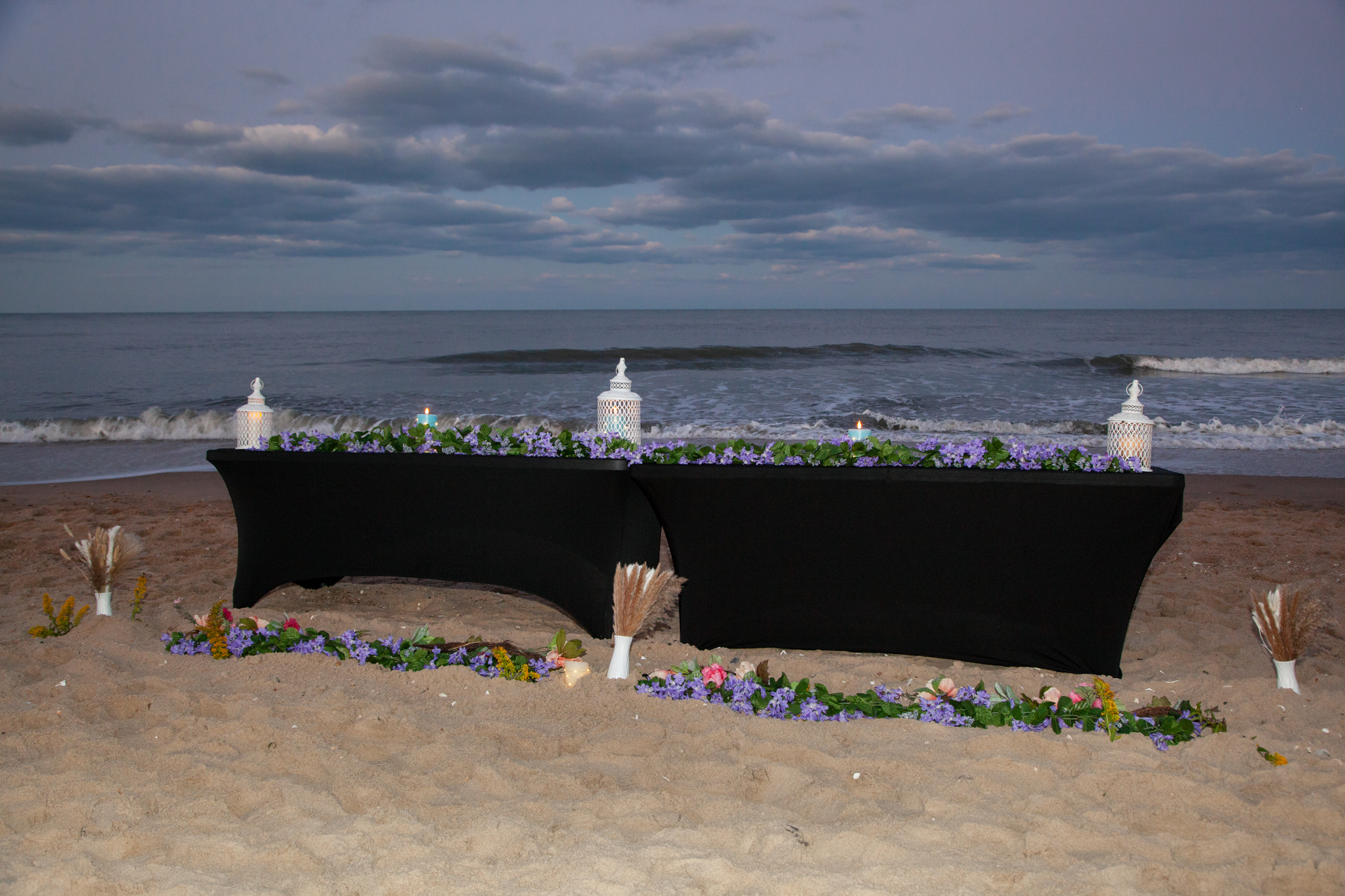
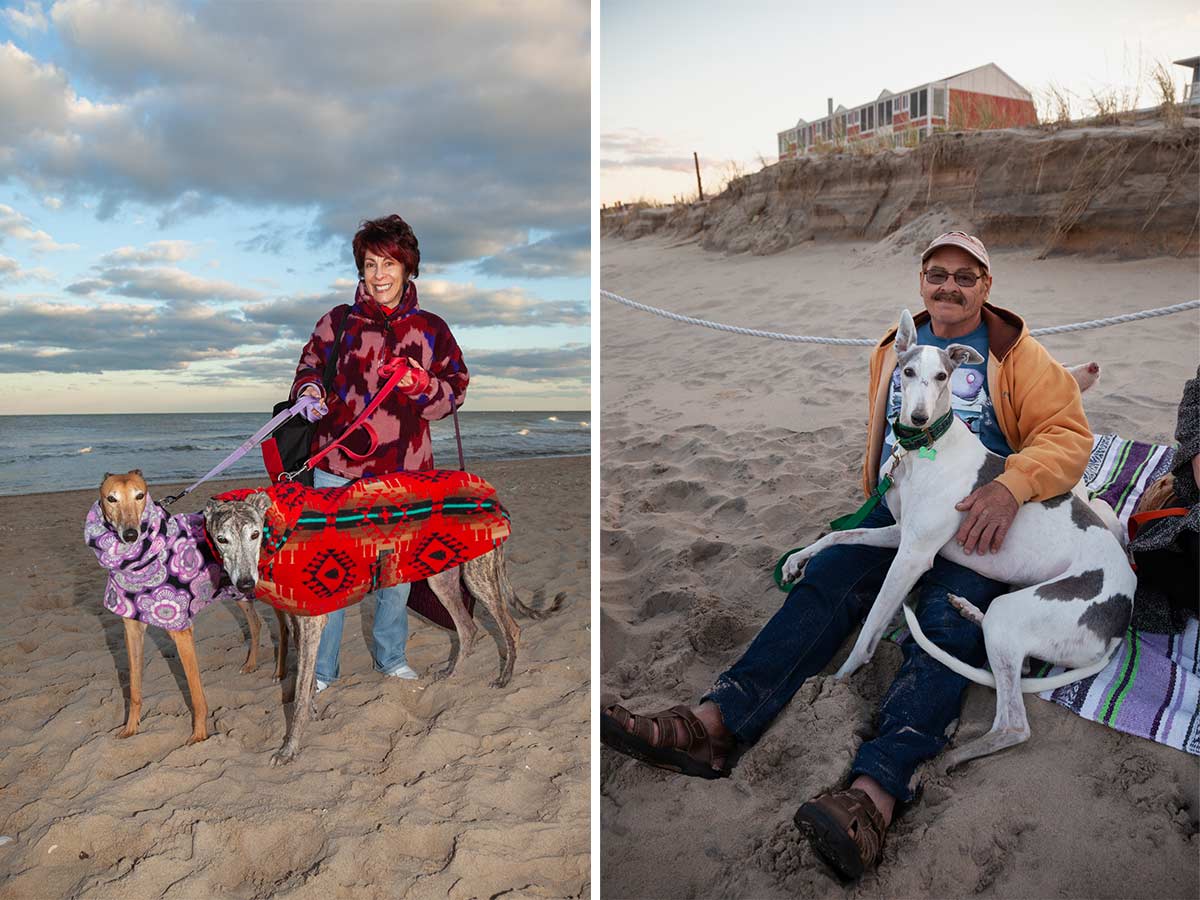
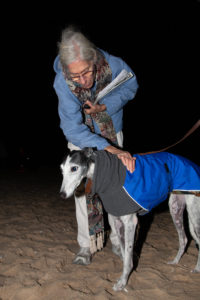
I had figured this would be a madhouse: a hundred or so greyhounds—former athletes, hefty creatures—gathered together on the sand. But it’s not. A few dogs lazily nose one another, while others quietly dig, then lie in their piles of sand. An older guy cradles a pale hound named Snapchat in his lap; Snapchat is the size of a small human teen. Most of the dogs are prone, down on blankets, swaddled in coats. A one-eyed greyhound sleeps in a shark costume, watched over by a man in a hound-patterned Hawaiian shirt. After about an hour, a single greyhound barks. The noise is so jarring that the owner jokes it’s a foghorn.
The pastor, a white-haired woman wearing an animal-print stole, stands to give the blessing, her back to the encroaching tide. As she speaks about “the sea, vast and spacious, teeming with creatures beyond number,” the speakers flash neon colors like a hot tub, and the moon backlights the clouds. The event’s climax is odd: The pastor invites the “rooing” to begin. In response, a couple of humans begin to howl and a choir of dogs join them. It’s a sound I’ve never heard from any creature—somewhere between singing and whining and growling and wailing. There’s bass and treble, some percussive low barks.
Morticia lifts her head from her blanket, ears roving atop her skull like satellite dishes, but she stays silent, obviously confused. Up front, one huge black dog is crooning his heart out at the full moon. When the rooing ends, a woman behind me admonishes her dog: “You didn’t roo! Maybe if there had been a raccoon.”
Roaming the beach, the pastor distributes individual blessings to the scattering hounds. When we flag her down, she places her hands on Morticia’s back and asks, “Who do we have here?” For a moment, I panic: This ravishing animal is named for Morticia Addams, a woman with the fragrance of satanism. To be polite, I opt for her nickname. “This is Toosh,” I say brightly. The pastor takes a moment before she reacts: “Sorry, your dog’s name is Douche?”
Beneath the convention’s revelry, it’s possible to detect some malaise. This is a time of great anxiety for the greyhound community. In the past four years, all but two American dog tracks have planned to close—perhaps a victory for animal welfare, but less so for greyhound enthusiasts, who fear that the breed may be in terminal decline. The majority of greyhounds are bred for racing, and fewer dogs racing means fewer dogs retiring, which means fewer dogs to adopt. If you love greyhounds enough to spend your long weekend buying greyhound-themed bracelets and bumper stickers and lanyards and flags, then fewer adoptable dogs is most unwelcome news.
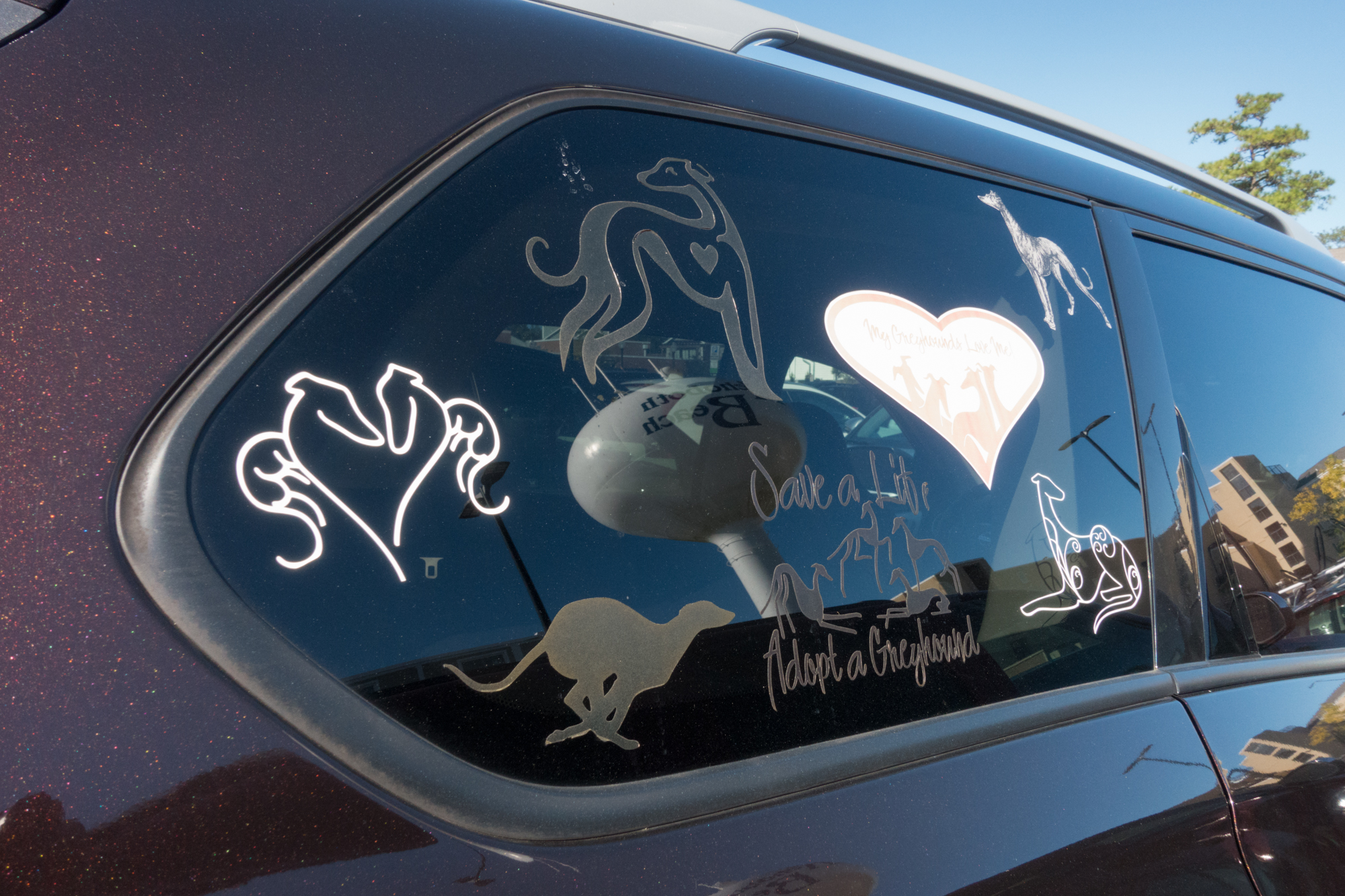
Among this crowd, the appetite for puppies is weak. Greyhound puppies are broadly maligned, considered nettlesome and destructive pets. “Velociraptors,” “land sharks,” “proper little hellions,” and “prone to using the furniture as a trampoline” are several of the descriptions I heard. In greyhound world, the retired racer is king: mellow, housebroken, with a full set of teeth. A few people at the convention seem puppy-curious, but most say they’ll simply import ex-racers from Ireland or Australia when the American pipeline runs dry.
This may not be enough. At a somber lecture called “Who Will Breed—and Test—the American Greyhound in the Future?,” the speaker says that the breed’s survival depends on our willingness to buy puppies, which he insists are not as bad as everyone thinks. He’s probably right that importing retired racers can’t satisfy American demand, but nobody seems willing to dwell on the issue. “It’s a concern,” says one lecture-goer of the shortage of retiring greys. “But the way I see it, the breed has been around since the Egyptians—it’s not going anywhere.”
It’s Sunday morning, the final day of the convention, and I’m with a disheveled Jack Sparrow impersonator—a human—whom the event has hired to lead the “Greyhounds of the Caribbean” parade. It’s the last event of the weekend: a hundred or so pirate-garbed hounds marching down the Rehoboth boardwalk. Some of them wear bandannas, others skull-and-crossbones fleeces or velvet hats with extravagant plumes. A trench-coated man from New York City has sewn matching costumes for himself and his dog: red-and-blue-striped shirts and pirate hats. For days, the dog wore his hat around the house to practice not pawing it off.
The boardwalk’s shoulders are clotted with spectators, dogless families filming the odd procession on their phones. Children are clapping, and an older couple in a pedicab is trapped, unable to part the sea of hounds. “This is a hoot,” the guy says. One dog peers into the open door of a toy store, threatening to lunge at a stuffed rabbit, while a mob of greyhounds sniffs at the French toast and Benedicts that unfortunate boardwalk brunchers warily guard.
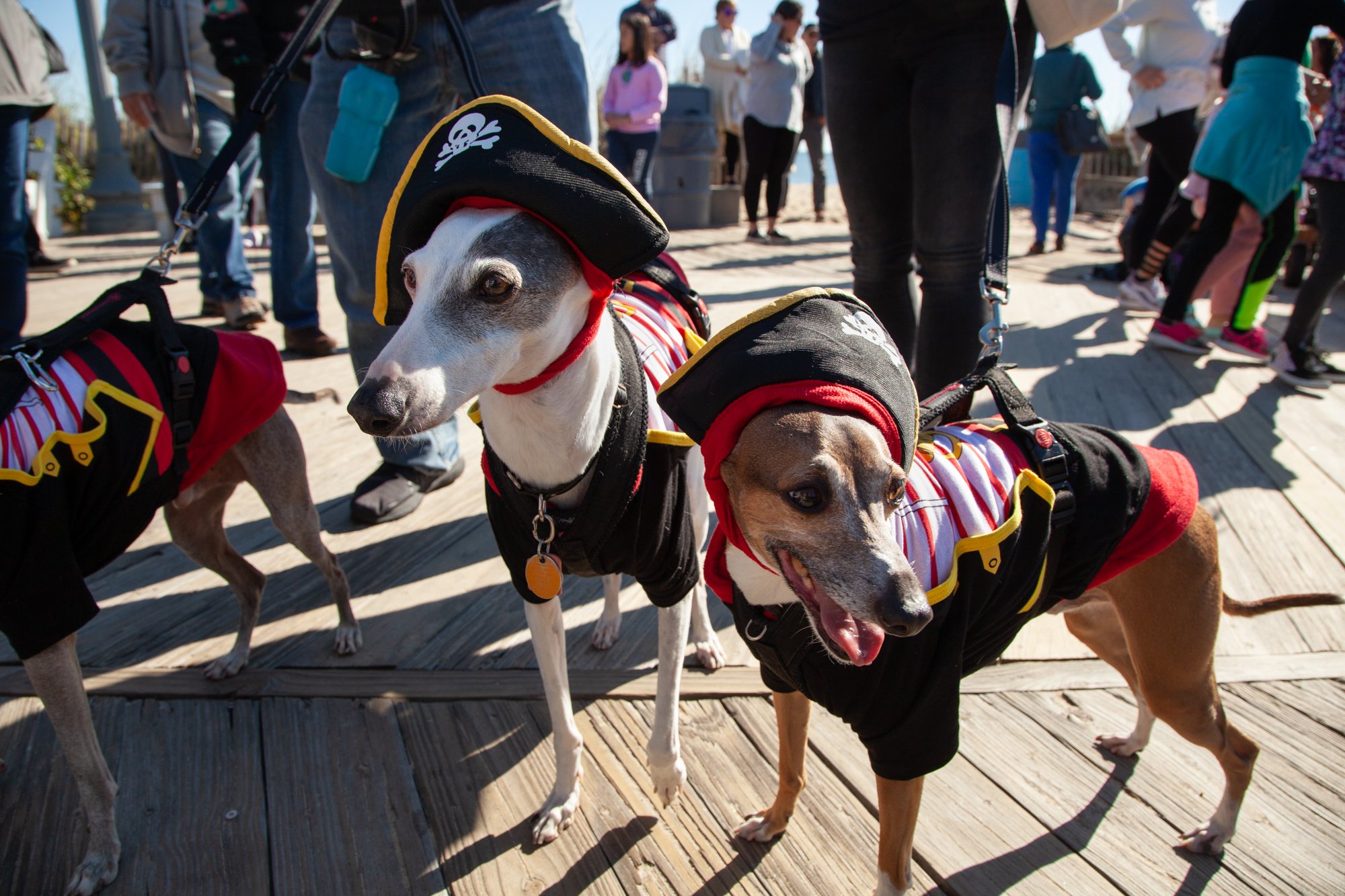
At the front of the parade, the Greyhounds of the Caribbean banner is flanked by the event’s “lead dogs.” Jeffrey is sporting a black tricorn with beaded dreads, and Mindy wears a lacy white bodice, a quaint little bonnet atop her head. The creator of these costumes is Lessa Shiffer, who works with Greyhound Pet Adoptions of Delaware. “It makes him look a little regal,” she says of Jeffrey’s hat. “I try not to do costumes that make them look foolish. I don’t want people to make fun.”
I ask Shiffer if we’re witnessing the last hurrah of the American greyhound, if this odd band of critters might soon go extinct. No, she says, gesturing to the hound-choked boardwalk, to the greyhound fanatics who have come from as far away as Staten Island and San Antonio and Atlanta to celebrate these dogs. Sure, the greyhound supply has dwindled, but a straw poll of conventioneers indicates that demand remains strong: Not a soul claims to be willing to switch to another breed. “After you get a greyhound, they kind of run in your blood,” Shiffer says.
When the parade disperses, I take Morticia for a final frolic on the beach. Jack Sparrow is there, ambling toward the water, his eye makeup smeared. I ask him how he got roped into being the actor for the greyhound event, and he’s grouchy. “Because I don’t know how to say no,” he snaps. Then he pets Morticia and softens. Actually, he’s a fan of the breed. He has a greyhound at home.
This article appears in the December 2022 issue of Washingtonian.


















